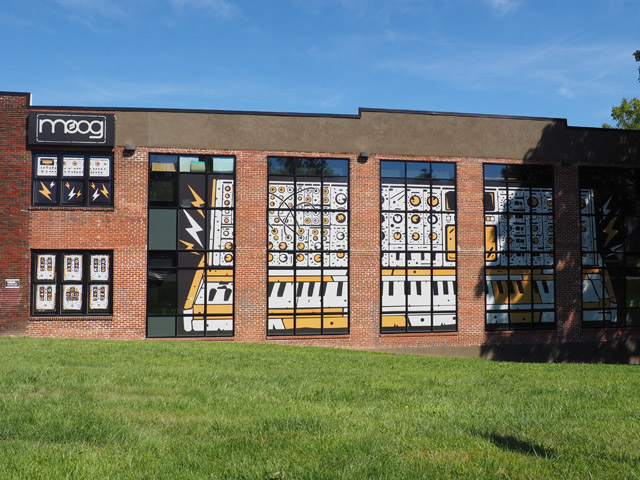Sometimes the best experiences happen when they’re unplanned. Since my days as a music gear-obsessed teenager I’ve known that Asheville, NC, is the home of Moog Music. But to be fully transparent my first pilgrimage to Asheville had a different agenda: craft beer.
Asheville, one of the more progressive cities situated in the western part of North Carolina, has become a mecca for those whose beliefs tend to lean left. Though there have been concerns that Asheville is gentrifying, the city has a magical mix of art, culture and temperate weather.
After imbibing choice stouts, porters and ales at Burial, Greenman, and Wicked Weed’s Funkatorium, I ventured down Lexington Avenue, a street sprinkled with restaurants and quaint shops. Ten minutes or so later is Broadway and there stands a delightfully surprising sight: Moog Music‘s headquarters in all of his humble splendor.
Enter the building and there’s a shop peddling Moog equipment and an array of branded chatkchas like these adorable magnets.
There’s an assortment of books, T-shirts, glasses and mugs … they’re hard to resist. My first instinct was to hand over my credit card and buy everything.
The back wall of the store is emblazoned with a photo and inspirational quote from founder Bob Moog: “To be human, to be fully human, is to need music and to derive nourishment from the music you hear. What you do with our instruments helps us to be more human, too, and I want to thank you all for that.”
What’s great is how visitors are encouraged to noodle with the gear. I slipped on a pair of headphones and played a Moog Sub 37, a limited edition (2-note) paraphonic analog synthesizer built on the Sub Phatty sound engine.
A series of Moog effects pedals were positioned on the floor a few inches in front of an Orange amplifier. (I resisted the urge to shred.)
The shelves were stocked with Moogerfoogers and more!
The Moog Minitaur is a subharmonic bass machine. It proved how low it can go.
The Theremini is a Theremin with a traditional heterodyning oscillator for pitch control combined with a sound engine derived from the Animoog synth. The electronic instrument was developed in the 1920s by Russian inventor Leon Theremin. Bob Moog founded his first company, R.A. Moog Co., to manufacture theremin kits, in 1953 at the age of 19. Theremins are engrained in the company’s DNA.
As I browsed, a friendly Moog employee introduced himself. He asked if I had any questions. He told me there were a few spots left on the afternoon factory tour and invited me. I jumped at the chance to get a behind the scenes look and returned a few hours later.
While waiting with a handful of synth enthusiasts for the tour to begin, I looked over and noticed one of the employees talking with a man. It turned out to be P-funk bass legend Bootsy Collins, who had stopped into town. Holy crap.
The tour began with a history of Moog Music. Dr. Bob Moog founded the company in Trumansburg, NY, in the late ’60s building modular synthesizers for musicians. He sold the company, only to buy it back.
The tour guide opened the factory doors and we were ushered onto the production floor. It was a sight to behold. Workers were going about their business, building synths by hand. It was a calm environment with a lot of focus. It’s notable to mention that Moog became employee-owned in 2015.
Nearly all of the work on the units is done at the factory. Instruments are hand-crafted in the two-level building. Shipping and receiving is located next door. High standard of quality. QA testing is engrained in their DNA.
It’s a small operation of maybe 50 workers. They buy their wood for a vendor in Knoxville, TN, and metal from a company in St. Louis. Bolts are screws are sourced in Asheville.
Instruments awaiting review in the QA area:
Overall, the tour of Moog Music’s factory was enlightening. It gave me deeper knowledge about the brand’s history, core values and dedication to quality. Moog’s instruments are on the pricey side of the spectrum. But this tour gave me a clear understanding why. Looking at a stack of boxes ready for shipment made me wonder how it has the wherewithal to empower an artist to create a transformative piece of music some time in the future.
Images by Darren Ressler



















